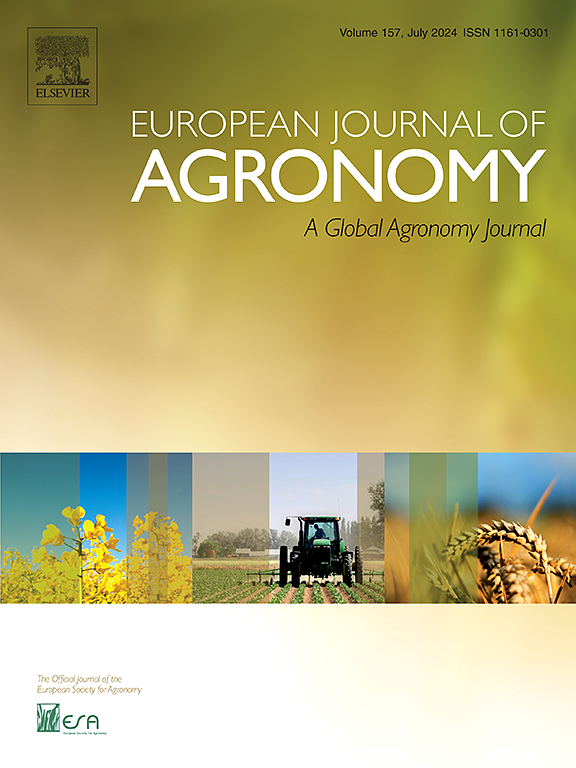南方红壤旱地种植模式和土壤类型驱动下土壤酸化的空间异质性
IF 5.5
1区 农林科学
Q1 AGRONOMY
引用次数: 0
摘要
中国南方红壤旱地是全国酸性土壤面积最大的地区。以江西吉太盆地红壤旱地为研究对象,基于电荷平衡原理和主要元素的年产出和年投入计算酸碱产量,评价不同养分投入产出预算(作物种植和撂荒)下土壤酸化速率。半方差分析表明,土壤酸化率具有中等的空间自相关性,金核效应为49.97 %。结构因子和随机因子在土壤酸化速率的空间变异中所占比例相当,表明人为控制养分收支和土壤固有性质的影响。在农业管理下,芝麻田土壤酸化率最高(7.50 keq·ha−1·yr−1),油菜籽田最低(2.46 keq·ha−1·yr−1)。废弃地块土壤酸化缓慢(0.96 keq·ha−1·yr−1)。施用化学肥料对油菜地土壤酸化率的贡献最大(58.39 %),其他栽培地块除茬对土壤酸化率的贡献最大(芝麻44.66 %,花生138.70 %,红薯75.25 %)。施用有机肥是负贡献因子,缓解了所有耕地的土壤酸化。土壤酸化速率因土壤类型和母质的不同而有显著差异。土壤理化性质对酸化速率有线性和非线性的影响。本研究强调了营养收支和土壤性质在红壤旱地土壤酸化中的作用。有效控制红壤酸化需要旱地管理者注重养分投入产出和土壤质量改善,特别是优化氮肥类型和避免过度去除作物秸秆。本文章由计算机程序翻译,如有差异,请以英文原文为准。
Spatial heterogeneity of soil acidification driven by cropping patterns and soil types in red soil dryland of Southern China
The red soil dryland in southern China has the largest area of acidic soils countrywide. We calculated acid production based on the principle of charge balance and the annual output and input of major elements to evaluate soil acidification rate under different nutrient input-output budgets (crop cultivation and land abandonment) in red soil dryland of the Jitai basin in Jiangxi Province. Semi-variance analysis revealed moderate spatial autocorrelation in soil acidification rate, with a nugget effect of 49.97 %. Structural and random factors accounted for comparable proportions of spatial variation in soil acidification rate, indicating the impacts of artificially controlled nutrient budgets and inherent soil properties. Under agricultural management, soil acidification rate reached its highest level in sesame plots (7.50 keq·ha−1·yr−1), with the lowest rate in rapeseed plots (2.46 keq·ha−1·yr−1). Abandoned plots experienced slow soil acidification (0.96 keq·ha−1·yr−1). Chemical fertilizer application contributed the greatest to soil acidification rate in rapeseed plots (58.39 %), and crop removal contributed prominently in other cultivated plots (sesame: 44.66 %, peanut: 138.70 %, sweet potato: 75.25 %). Organic fertilizer application was a negative contributor, alleviating soil acidification in all cultivated plots. Soil acidification rate differed significantly with soil type and parent material. A range of soil physicochemical properties exhibited linear and nonlinear effects on soil acidification rate. This study underscores the role of both nutrient budgets and soil properties in driving soil acidification in red soil dryland. Effective control of red soil acidification necessitates dryland managers to focus on nutrient input-output and soil quality improvement, especially optimizing the type of nitrogen fertilize and avoiding excessive removal of crop straw.
求助全文
通过发布文献求助,成功后即可免费获取论文全文。
去求助
来源期刊

European Journal of Agronomy
农林科学-农艺学
CiteScore
8.30
自引率
7.70%
发文量
187
审稿时长
4.5 months
期刊介绍:
The European Journal of Agronomy, the official journal of the European Society for Agronomy, publishes original research papers reporting experimental and theoretical contributions to field-based agronomy and crop science. The journal will consider research at the field level for agricultural, horticultural and tree crops, that uses comprehensive and explanatory approaches. The EJA covers the following topics:
crop physiology
crop production and management including irrigation, fertilization and soil management
agroclimatology and modelling
plant-soil relationships
crop quality and post-harvest physiology
farming and cropping systems
agroecosystems and the environment
crop-weed interactions and management
organic farming
horticultural crops
papers from the European Society for Agronomy bi-annual meetings
In determining the suitability of submitted articles for publication, particular scrutiny is placed on the degree of novelty and significance of the research and the extent to which it adds to existing knowledge in agronomy.
 求助内容:
求助内容: 应助结果提醒方式:
应助结果提醒方式:


